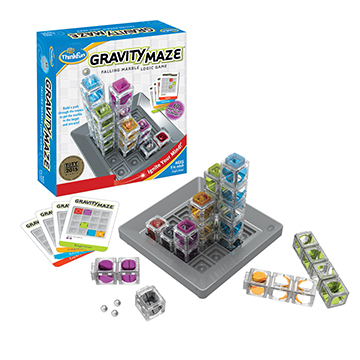Gravity Maze: Falling Marble Logic Maze Game
Short description
The “Gravity Maze” game is a “gravity-powered logic maze game that builds reasoning skills and visual perception.” The task is to “strategically place towers and create a path for [a] marble to reach the target”. There are 60 challenges to test and develop your skills. It is meant to be played by one player (8+ years old), but small groups of players can also collaborate to solve the different puzzles together. Players need to complete a sequence of “steps” from top to bottom, that the marble takes to reach a target position.
Material and technical aspects
The game is composed of 1 plastic game grid, 10 plastic towers, 3 stainless steel marbles, 60 challenges cards and 1 instruction manual. No electricity nor screen is required. It costs about 30€ to buy.
Content
In terms of computational thinking, the marble maze game focuses on problems that require players to complete “instructions” to move the marble from an initial position (highest point) to a target position (lowest point). These instructions are “given” by adding towers with holes and shapes inside that guide the marble either downwards, to the left or to the right. It also naturally encourages a trial-and-error problem-solving strategy to see what happens when launching the marble with the initial set of towers in place and then progressively guiding it better and better towards the target location.
Pedagogical aspects
From a pedagogical point of view, this learning resource uses game play as a fun and implicit learning experience. It is supposed to create opportunities to test your problem-solving skills when confronted with problems. Learning is supposed to happen through experimentation, by trying out solutions, seeing in how far they are helpful, correcting if necessary and then incrementally adding elements to the solution. You can dare to make mistakes and learn from them. The game is built to be played by single players, but they can also be played by small groups of children who collaboratively discuss and implement solutions to solve the riddles.
Conclusion
Overall, this logic game is a fun to play and nevertheless challenging learning activity that helps children develop a strategy of iterative problem-solving where they do not need to fear to make mistakes.

